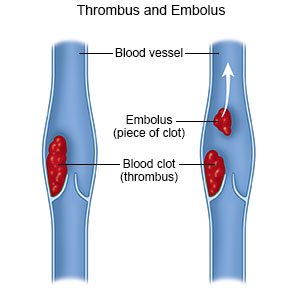An embolus is a blood clot that most commonly originates in the veins of the legs (deep vein thrombosis). The blood clot can dislodge and travel as an embolus to other organs in the body, generally the lungs. A pulmonary embolism is a clot that lodges in the lungs, potentially blocking one or more of the pulmonary arteries and reducing blood flow to a region of the lungs.
When coding pulmonary embolism, it’s important to pick up the different areas that the patient may have: Saddle embolus, Segmental, Subsegmental or all three. Acuity is also important so there are codes for acute and chronic. This specificity is typically documented in the body of a procedure note, such as a thrombectomy, or in a radiology report.
Coding Clinics
There are multiple Coding Clinics that help with the coding of pulmonary embolisms. They state that you would code each type and location and that multiple codes are needed to fully capture a patient’s condition and extent of disease. There are no Excludes 1 notes or other official directives that indicate these would not be reported together. CAC will not point this out or pick up on the other codes. It’s important to code these ICD-10-CM codes as they often affect the SOI/ROM.
Coding Clinic, 2nd QTR 2022, pg. 13 tells us that the patient had a CTA which revealed pulmonary emboli in the segmental branches of the right middle and lower lobes of the lung. Also, emboli in the subsegmental branches of the right and left lobes of the lung.
Answer: Assign codes I26.99, other pulmonary embolism without acute cor pulmonale and I26.94, multiple subsegmental pulmonary emboli without acute cor pulmonale. In this case, the patient had segmental emboli in the proximal branches of the right middle and lower lobes as well as bilateral subsegmental emboli. Two codes are needed to fully capture the patient’s condition.
Coding Clinic, 2nd QTR 2021, pgs. 9-10 discusses a patient diagnosed with chronic bilateral subsegmental pulmonary emboli (PE). In the Alphabetic Index under Embolism, pulmonary, there are separate subentries at the same indentation level for chronic and multiple subsegmental. What is the correct code assignment for chronic bilateral subsegmental pulmonary emboli?
Answer: Assign codes I26.94, multiple subsegmental pulmonary emboli without acute cor pulmonale, and I27.82, chronic pulmonary embolism, for bilateral chronic subsegmental pulmonary emboli. Both codes are needed to fully describe the patient’s condition.
When coding DVT (deep vein thromboses), review documentation for the specific location of the thrombus. Radiology reports can be used here to pick up the specificity. If a thrombectomy is being performed, verify if the work is arterial or venous to obtain the correct code.
References
Coding Clinic, 2nd Quarter 2022, page 13 “Segmental and Subsegmental Pulmonary Emboli”
Coding Clinic, 2nd Quarter 2021, pg. 9-10 “Bilateral Chronic and Subsegmental Pulmonary Embolism”
Coding Clinic, 4th Quarter 2019, pgs. 6-7 “Subsegmental Pulmonary Embolism”
3M ICD-10-CM/PCS Integrated Codebook
Dorland’s Medical Dictionary






